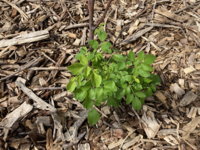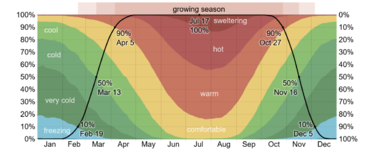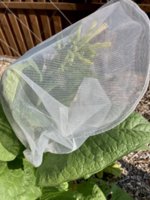continuing on from the above post update the potatoes are doing great

You can see from the flowers that over the untold years of breeding the potato has become highly in-bred, same with the tomatoes. There is breeding work making out-crossing tomatoes that has increased flower size, restored flower coloring and pistil stigmas that extend outward and beyond the stamens of the flower allowing for out-crossing. I have not read news on the latest but the current works was to breed the self-incompatible gene into the tomato plants so they have to out-cross or die, with the goal of bringing rapid genetic mixing and enhancement to tomatoes to help fight of the new waves of diseases that will pretty much decimate all the existing heirloom and tomato breeds.
Of to the side you can see the Moringa trees I got from Mexico, here is a more recent photo of some of the seed planting clusters I put along the back fence.

And here is some of my mixed row plantings, I have sweet potatoes, cow peas and some potatoes coming up in these rows.

Before I forget I did have some watermelon seeds. I wasn't planning on growing watermelon, but for some reason must have gotten one packet. They are not exciting, they are just as tiny and poor performing as Hales Worst Muskmelon seeds are performing. However, Joseph Lofthouse has provided a photograph side by side of his landrace watermelon project (explosive growth) side by side planted with retail store named varieties of watermelons. Joseph grows everything subsistence style, all he provides is irrigation if needed, there are zero fertilizer inputs, zero pest spraying, etc. The whole goal of landrace development is to re-establish plants that actually sent roots down deep to gain access to nutrients and the water table, that activate and use their genetics to co-exist with pests, etc. rather than plants that have genetically self-selected to put down shallow roots to pick up chemical synthetic fertilizer inputs, who don't need to worry about pest weakness in their genetics due to being bathed in chemical pesticides, and are in general selected by the growers for long storage life (removes taste, aroma).
Commercial Watermelon Seeds on the Left.
Lofthouse landrace Watermelon on the Right.
Same planting field, same planting day. Same growing conditions.

I am having fun with the fruit trees, all are growing out and I am getting to play with the plasticity of life especially in the early months where the stems are pliable and easily trained. Normally I set an extremely low scaffold in a four point east/west/north/south orientation but with this one apple all I had to work with for now was the three branches. I could do three points and wait for some of the excessive growth on the bud/stem location to possibly branch out and do a fourth, but I am going to experiment and just do a three-point scaffold and compare the final fruit production to the four-point apple trees. Not terribly scientific as they are all different varieties.

You can see a little foot action for scale and ties into the Lofthouse landrace Watermelon photo above. I garden like this all the time now, I have no more mud, and unlike the nay-sayers I don't have explosions of fire ants, in fact I have less fire ants and I don't like how modern plastic made shoes allow people to grow interesting and exotic forms of fungi under their nails
Speaking of natural fungi... well I don't have a good segue into bacterium so I'll just post a photo of kraut making day. I'll save the readers seeing progression, instead here is a five gallon crock with the first barrier layer of outer cabbage leaves, it was then topped with a secondary barrier and then weights and a towel tied around to keep any insects away until its done with the various lactobacillus species making more nutrients available in the cabbage.

The morning glory out front I have utterly neglected, even though small they are already flowering.

The growing totes are doing excellent. If you recall all they have in them is a lasagna layer of woodchips, then lawn clippings, and the repeat woodchips and lawn clippings.

You can see I am getting rid of some brassica off cuts.

Finally some tobacco shots. Tobacco plants are extremely shallow rooting and the woodchips were laid on the ground a foot deep at the end of last year.

Hand for scale.

And its not just the plants growing big, here is a jumping spider, the largest I have seen so far in the garden since converting to woodchips.

That is a close up, so here is a better to scale photo.

Still small but a lot larger than any jumping spider I have seen to date. No photos but I also have a lot of wasp nests, I am 100% growing wasps while every other house in this estate is spraying poisons on them to kill them instantly. Wasps are my garden friend and do a good job taking out caterpillars naturally.

You can see from the flowers that over the untold years of breeding the potato has become highly in-bred, same with the tomatoes. There is breeding work making out-crossing tomatoes that has increased flower size, restored flower coloring and pistil stigmas that extend outward and beyond the stamens of the flower allowing for out-crossing. I have not read news on the latest but the current works was to breed the self-incompatible gene into the tomato plants so they have to out-cross or die, with the goal of bringing rapid genetic mixing and enhancement to tomatoes to help fight of the new waves of diseases that will pretty much decimate all the existing heirloom and tomato breeds.
Of to the side you can see the Moringa trees I got from Mexico, here is a more recent photo of some of the seed planting clusters I put along the back fence.

And here is some of my mixed row plantings, I have sweet potatoes, cow peas and some potatoes coming up in these rows.

Before I forget I did have some watermelon seeds. I wasn't planning on growing watermelon, but for some reason must have gotten one packet. They are not exciting, they are just as tiny and poor performing as Hales Worst Muskmelon seeds are performing. However, Joseph Lofthouse has provided a photograph side by side of his landrace watermelon project (explosive growth) side by side planted with retail store named varieties of watermelons. Joseph grows everything subsistence style, all he provides is irrigation if needed, there are zero fertilizer inputs, zero pest spraying, etc. The whole goal of landrace development is to re-establish plants that actually sent roots down deep to gain access to nutrients and the water table, that activate and use their genetics to co-exist with pests, etc. rather than plants that have genetically self-selected to put down shallow roots to pick up chemical synthetic fertilizer inputs, who don't need to worry about pest weakness in their genetics due to being bathed in chemical pesticides, and are in general selected by the growers for long storage life (removes taste, aroma).
Commercial Watermelon Seeds on the Left.
Lofthouse landrace Watermelon on the Right.
Same planting field, same planting day. Same growing conditions.

I am having fun with the fruit trees, all are growing out and I am getting to play with the plasticity of life especially in the early months where the stems are pliable and easily trained. Normally I set an extremely low scaffold in a four point east/west/north/south orientation but with this one apple all I had to work with for now was the three branches. I could do three points and wait for some of the excessive growth on the bud/stem location to possibly branch out and do a fourth, but I am going to experiment and just do a three-point scaffold and compare the final fruit production to the four-point apple trees. Not terribly scientific as they are all different varieties.

You can see a little foot action for scale and ties into the Lofthouse landrace Watermelon photo above. I garden like this all the time now, I have no more mud, and unlike the nay-sayers I don't have explosions of fire ants, in fact I have less fire ants and I don't like how modern plastic made shoes allow people to grow interesting and exotic forms of fungi under their nails
Speaking of natural fungi... well I don't have a good segue into bacterium so I'll just post a photo of kraut making day. I'll save the readers seeing progression, instead here is a five gallon crock with the first barrier layer of outer cabbage leaves, it was then topped with a secondary barrier and then weights and a towel tied around to keep any insects away until its done with the various lactobacillus species making more nutrients available in the cabbage.

The morning glory out front I have utterly neglected, even though small they are already flowering.

The growing totes are doing excellent. If you recall all they have in them is a lasagna layer of woodchips, then lawn clippings, and the repeat woodchips and lawn clippings.

You can see I am getting rid of some brassica off cuts.

Finally some tobacco shots. Tobacco plants are extremely shallow rooting and the woodchips were laid on the ground a foot deep at the end of last year.

Hand for scale.

And its not just the plants growing big, here is a jumping spider, the largest I have seen so far in the garden since converting to woodchips.

That is a close up, so here is a better to scale photo.

Still small but a lot larger than any jumping spider I have seen to date. No photos but I also have a lot of wasp nests, I am 100% growing wasps while every other house in this estate is spraying poisons on them to kill them instantly. Wasps are my garden friend and do a good job taking out caterpillars naturally.















